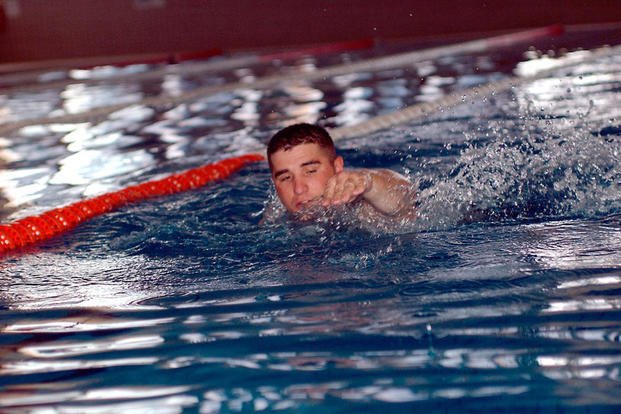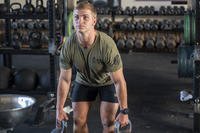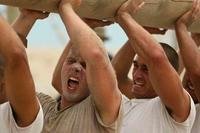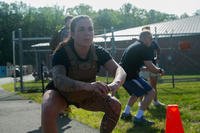Stew Smith, Military.com's tactical fitness expert, answers three emails during this week's Ask Stew mailbag.
1. A college student prepares for a special-ops career.
So I just started the first week of your AF Combat Rescue Officer workout program. I have to say, I thought I was in shape, but this is tough! Love it!
First, how important is nutrition when doing your program? I know eating healthy is important, but do I need to be eating no junk food at all?
With a crazy schedule complete with work, school and family stress, nutrition is more important than when you're not working out. It is critical to your success, and so is sleep. Otherwise, you never will be able to recover properly. All of these, not just nutrition, are very important for performance.
Second, as of right now I'm in college, in ROTC, have a job and a pregnant wife. I saw on your workout plan that you said you can split up the workouts, but you suggest that people get it all done in the same day.
Do you have any suggestions for someone like myself who has very little time to work in all of the workouts? Between the running, rucking, swimming, travel time and the workout itself, it can take me close to two hours to complete it all. Again, thank you very much for the tough workout and the insight! Thanks, Dave
I would break the workouts into two sessions. Maybe get your PT/lift in the morning or run if that is easier. Then do what is left either at lunch, between classes or in the evening. We always had to do two-a-days in college, as some of these Special Ops prep workouts take two hours or more.
And when you have to skip some longer workouts, move some of the longer events to the weekend.
2. Getting back in the pool again.
Stew, I have been powerlifting and rucking for more than a year now and thinking of giving my legs a break and adding swimming this winter. Any recommendations on strokes and start-up distances? My lungs are OK but not in swim shape. Thanks, Scott.
I would get in the pool and give it a test. See how far you can swim, using any or all of the strokes you know without stopping. If you actually do pretty well and can get 400-500 meters without stopping, try doing a reverse pyramid of distance for starters so each set gets easier.
Your workout will look like this: 400 meters, rest one minute; 300 meters, rest one minute; 200 meters, rest one minute; 100 meters, rest one minute. This swim totals 1,000 meters and is a good starting point.
If you only get 100 meters or less before you have to stop, try doing super sets of that distance for 5-10 sets with a 30- to 60-second rest interval. For instance, if you only can get 100 meters, set the workout up as follows:
Repeat 5-10 times
- Swim 100 meters
- Rest 30-60 seconds
Both workouts start off slowly and total 500-1,000 meters of swim time, but for someone who has not swum in a while, you will feel it. But you will progress quickly if you do these workouts 3-4 days a week, adding as much distance as you can handle each day.
3. Post heart bypass, a running goal turns to a rowing goal.
I'm 64. After recovering from a heart attack and triple bypass in 2010, I set passing the U.S. Army fitness test as a recovery goal. I chose this because it was calibrated for my age, simple and seemed both challenging and feasible. After several months of strength training, I passed the push-up/sit-up tests. Though I was, at best, about a few minutes (22 minutes) off the minimum two-mile run of 19:50. But over two running seasons, I ended up with injuries that stopped my running workouts.
Although nothing compares with running, I like rowing machines. So I want to figure out what rowing time/distance would be comparable to a minimum pass of the APFT two-mile run, calibrated for my age, so I can meet my goal on a rowing machine. Any suggestions you might have about this would be greatly appreciated.
First of all, great job on making and sticking to fun and challenging fitness goals. They help keep you focused. Running can be hard on the body, so mixing in some non-impact options is always a smart idea. I would row the time it takes you to run two miles, so shoot for 20-22 minutes and see how far you get on the rower.
The machine should have a range of 300-400 calories burned at this distance with moderate effort on your part. This also happens to be a rough estimate of how many calories you would burn on your two-mile run. Note your distance and focus your progressions on going farther each workout per 20-22 minutes of work on the rower. Work on a goal of making that distance you started with 22 minutes to under 20 minutes. Should be a fun challenge for you.
Stew
Stew Smith is a former Navy SEAL and fitness author certified as a Strength and Conditioning Specialist (CSCS) with the National Strength and Conditioning Association. Visit his Fitness eBook store if you're looking to start a workout program to create a healthy lifestyle. Send your fitness questions to stew@stewsmith.com.
Want to Learn More About Military Life?
Whether you're thinking of joining the military, looking for fitness and basic training tips, or keeping up with military life and benefits, Military.com has you covered. Subscribe to Military.com to have military news, updates and resources delivered directly to your inbox.


















